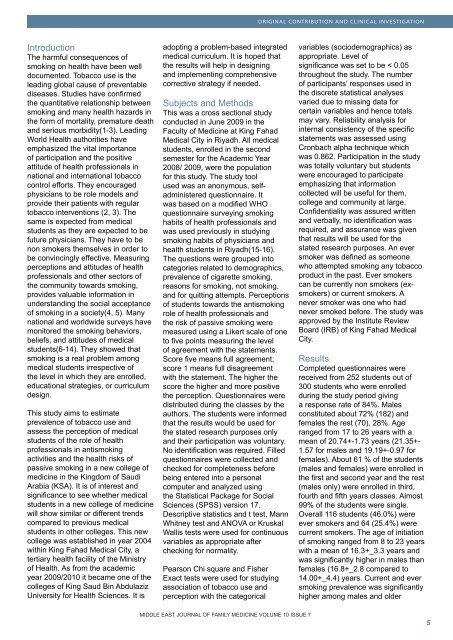full pdf of issue - Middle East Journal of Family Medicine
full pdf of issue - Middle East Journal of Family Medicine
full pdf of issue - Middle East Journal of Family Medicine
- No tags were found...
You also want an ePaper? Increase the reach of your titles
YUMPU automatically turns print PDFs into web optimized ePapers that Google loves.
ORIGINAL CONTRIBUTION AND CLINICAL INVESTIGATIONIntroductionThe harmful consequences <strong>of</strong>smoking on health have been welldocumented. Tobacco use is theleading global cause <strong>of</strong> preventablediseases. Studies have confirmedthe quantitative relationship betweensmoking and many health hazards inthe form <strong>of</strong> mortality, premature deathand serious morbidity(1-3). LeadingWorld Health authorities haveemphasized the vital importance<strong>of</strong> participation and the positiveattitude <strong>of</strong> health pr<strong>of</strong>essionals innational and international tobaccocontrol efforts. They encouragedphysicians to be role models andprovide their patients with regulartobacco interventions (2, 3). Thesame is expected from medicalstudents as they are expected to befuture physicians. They have to benon smokers themselves in order tobe convincingly effective. Measuringperceptions and attitudes <strong>of</strong> healthpr<strong>of</strong>essionals and other sectors <strong>of</strong>the community towards smoking,provides valuable information inunderstanding the social acceptance<strong>of</strong> smoking in a society(4, 5). Manynational and worldwide surveys havemonitored the smoking behaviors,beliefs, and attitudes <strong>of</strong> medicalstudents(6-14). They showed thatsmoking is a real problem amongmedical students irrespective <strong>of</strong>the level in which they are enrolled,educational strategies, or curriculumdesign.This study aims to estimateprevalence <strong>of</strong> tobacco use andassess the perception <strong>of</strong> medicalstudents <strong>of</strong> the role <strong>of</strong> healthpr<strong>of</strong>essionals in antismokingactivities and the health risks <strong>of</strong>passive smoking in a new college <strong>of</strong>medicine in the Kingdom <strong>of</strong> SaudiArabia (KSA). It is <strong>of</strong> interest andsignificance to see whether medicalstudents in a new college <strong>of</strong> medicinewill show similar or different trendscompared to previous medicalstudents in other colleges. This newcollege was established in year 2004within King Fahad Medical City, atertiary health facility <strong>of</strong> the Ministry<strong>of</strong> Health. As from the academicyear 2009/2010 it became one <strong>of</strong> thecolleges <strong>of</strong> King Saud Bin AbdulazizUniversity for Health Sciences. It isadopting a problem-based integratedmedical curriculum. It is hoped thatthe results will help in designingand implementing comprehensivecorrective strategy if needed.Subjects and MethodsThis was a cross sectional studyconducted in June 2009 in theFaculty <strong>of</strong> <strong>Medicine</strong> at King FahadMedical City in Riyadh. All medicalstudents, enrolled in the secondsemester for the Academic Year2008/ 2009, were the populationfor this study. The study toolused was an anonymous, selfadministeredquestionnaire. Itwas based on a modified WHOquestionnaire surveying smokinghabits <strong>of</strong> health pr<strong>of</strong>essionals andwas used previously in studyingsmoking habits <strong>of</strong> physicians andhealth students in Riyadh(15-16).The questions were grouped intocategories related to demographics,prevalence <strong>of</strong> cigarette smoking,reasons for smoking, not smoking,and for quitting attempts. Perceptions<strong>of</strong> students towards the antismokingrole <strong>of</strong> health pr<strong>of</strong>essionals andthe risk <strong>of</strong> passive smoking weremeasured using a Likert scale <strong>of</strong> oneto five points measuring the level<strong>of</strong> agreement with the statements.Score five means <strong>full</strong> agreement;score 1 means <strong>full</strong> disagreementwith the statement. The higher thescore the higher and more positivethe perception. Questionnaires weredistributed during the classes by theauthors. The students were informedthat the results would be used forthe stated research purposes onlyand their participation was voluntary.No identification was required. Filledquestionnaires were collected andchecked for completeness beforebeing entered into a personalcomputer and analyzed usingthe Statistical Package for SocialSciences (SPSS) version 17.Descriptive statistics and t test, MannWhitney test and ANOVA or KruskalWallis tests were used for continuousvariables as appropriate afterchecking for normality.Pearson Chi square and FisherExact tests were used for studyingassociation <strong>of</strong> tobacco use andperception with the categoricalvariables (sociodemographics) asappropriate. Level <strong>of</strong>significance was set to be < 0.05throughout the study. The number<strong>of</strong> participants’ responses used inthe discrete statistical analysesvaried due to missing data forcertain variables and hence totalsmay vary. Reliability analysis forinternal consistency <strong>of</strong> the specificstatements was assessed usingCronbach alpha technique whichwas 0.862. Participation in the studywas totally voluntary but studentswere encouraged to participateemphasizing that informationcollected will be useful for them,college and community at large.Confidentiality was assured writtenand verbally, no identification wasrequired, and assurance was giventhat results will be used for thestated research purposes. An eversmoker was defined as someonewho attempted smoking any tobaccoproduct in the past. Ever smokerscan be currently non smokers (exsmokers)or current smokers. Anever smoker was one who hadnever smoked before. The study wasapproved by the Institute ReviewBoard (IRB) <strong>of</strong> King Fahad MedicalCity.ResultsCompleted questionnaires werereceived from 252 students out <strong>of</strong>300 students who were enrolledduring the study period givinga response rate <strong>of</strong> 84%. Malesconstituted about 72% (182) andfemales the rest (70), 28%. Ageranged from 17 to 26 years with amean <strong>of</strong> 20.74+-1.73 years (21.35+-1.57 for males and 19.19+-0.97 forfemales). About 61 % <strong>of</strong> the students(males and females) were enrolled inthe first and second year and the rest(males only) were enrolled in third,fourth and fifth years classes. Almost99% <strong>of</strong> the students were single.Overall 116 students (46.0%) wereever smokers and 64 (25.4%) werecurrent smokers. The age <strong>of</strong> initiation<strong>of</strong> smoking ranged from 8 to 23 yearswith a mean <strong>of</strong> 16.3+_3.3 years andwas significantly higher in males thanfemales (16.8+_2.8 compared to14.00+_4.4) years. Current and eversmoking prevalence was significantlyhigher among males and olderMIDDLE EAST JOURNAL OF FAMILY MEDICINE VOLUME 10 ISSUE 7MIDDLE EAST JOURNAL OF FAMILY MEDICINE • VOLUME 7, ISSUE 10
















